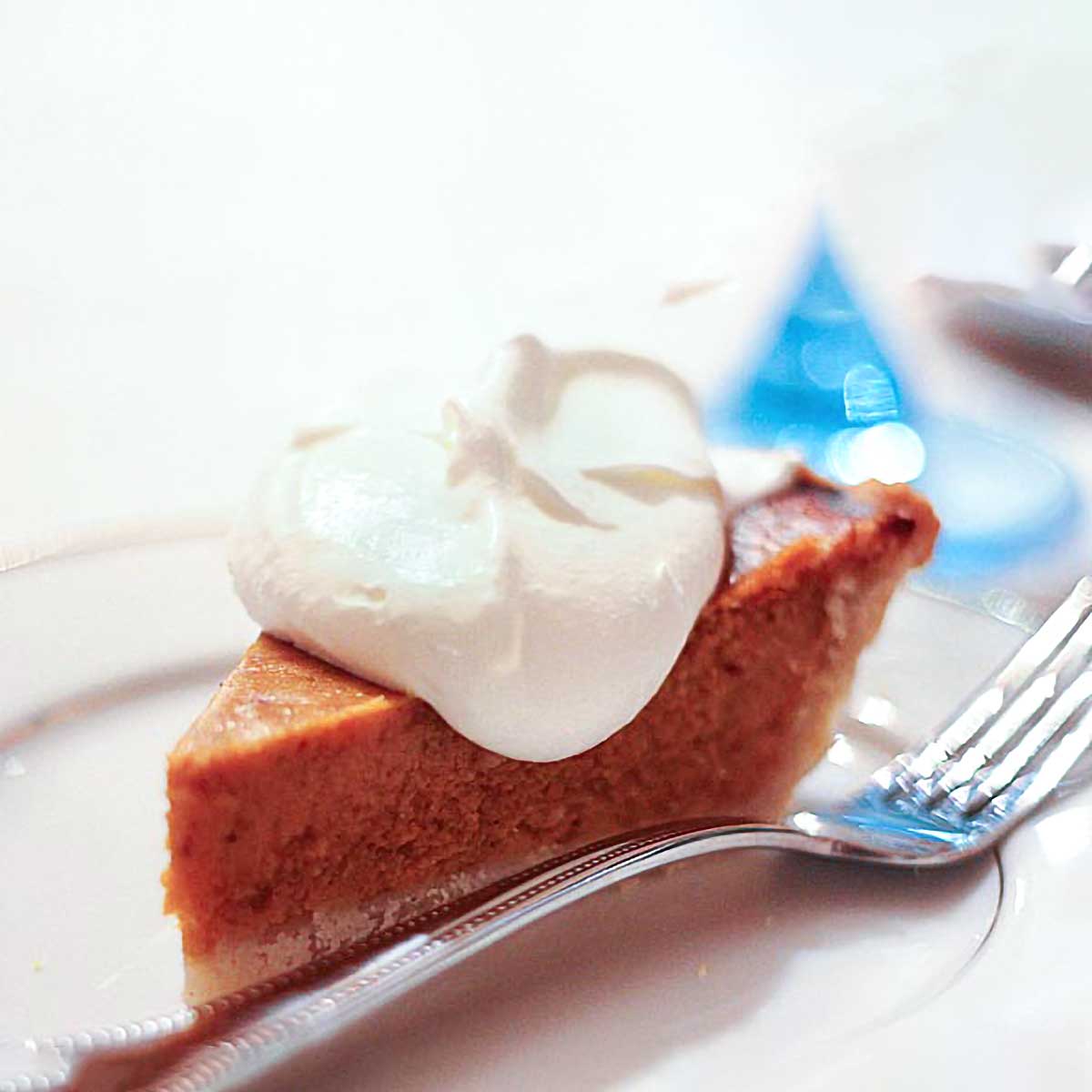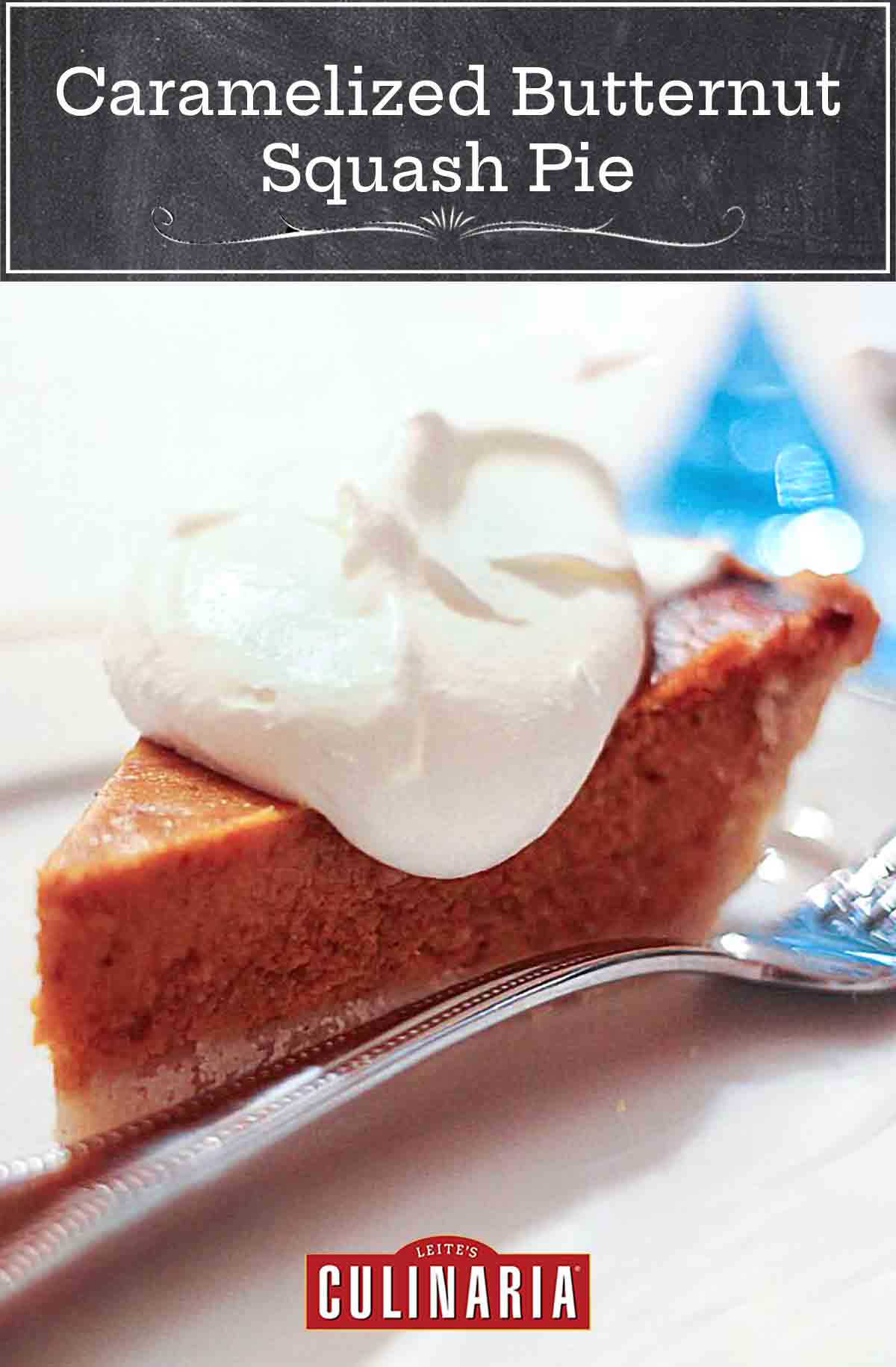
For years, my family used canned pumpkin in our pie. When you’re spooning in heaps of ginger powder, cinnamon, clove, and grated ginger, we all thought, it hardly matters whether you use canned mush or a fresh purée—it’s all just a vehicle for ferrying sugar and spices to your mouth.
At some point, while flipping through my dog-eared Fannie Farmer Cookbook, I noticed a recipe for winter squash pie. It called for winter squash purée in place of pumpkin purée; heavy cream in place of evaporated milk; and a fat dose of brandy along with the usual spices. I noticed that the proportions of cream to squash were higher than evaporated milk to pumpkin. I hoped this would make for a lighter pie, and I was right. And the brandy added a warm, sophisticated note.
Years later, when I discovered how easy butternut squash is to peel—the thin skin slips right off with a vegetable peeler—I could imagine tossing cubes of it with butter and sugar and cooking the squash until almost candied, then turning it all into my pie.–Melissa Clark
Caramelized Butternut Squash Pie FAQs
You’re going to want to pull the pie out before it’s overcooked so you need to know the signs that it’s ready to come out. The edges of the filling should be puffy but the center will still be a little sunken and jiggly. Not sloshing around but jiggly like Jell-O. Remember that your pie will continue to cook after it’s been taken out of the oven. You can also use an instant-read thermometer–your pie is done when it reaches 170℉.
A squash or pumpkin pie will crack when it’s been overbaked because the filling is basically a custard. When the filling gets too hot, the eggs contract and that’s when the cracks happen. To avoid this, learn how to identify when your pie is cooked. It also helps if you bake the pie in the lower third of the oven.
If the pie doesn’t get hot enough, the melting butter in the crust doesn’t get a chance to steam off the extra moisture, giving you a soggy bottom. And it will be underbaked, too. Bake your pie in the lower third of the oven, and use a glass pie plate so you can see if your crust is cooked all the way across. If it’s already cooked, you can try returning it to the oven. Cover with foil and bake at 425°F on the lowest rack, checking after 15 minutes.

Caramelized Butternut Squash Pie
Ingredients
- 1 Perfect Pie Crust
- 2 1/2 pounds butternut squash, peeled, seeded, and cut into 2-inch (5-cm) chunks
- 2 tablespoons (1 oz) unsalted butter, cut into pieces
- 2 teaspoons granulated sugar
- 1 cup heavy cream
- 1 large egg
- 2 large egg yolks
- 1/4 cup light brown sugar
- 3 tablespoon brandy
- 1 teaspoon vanilla extract
- 1 1/2 teaspoons ground ginger
- 1 to 2 teaspoons finely grated ginger, or more to taste
- 1/4 to scant 1/2 teaspoon freshly grated nutmeg
- 1/2 teaspoon ground cinnamon
- Pinch kosher salt
Instructions
- Place the pie crust dough between 2 sheets of plastic wrap and roll it into a 3/8-inch-thick round. Line a 9-inch pie pan with the dough. Use your thumb and forefinger to flute the edges and refrigerate for at least 30 minutes or up to 1 day. (If chilling the dough for more than 2 hours, lightly cover the dough with plastic.)
- Preheat the oven to 375°F (190°C).
- Line the crust with foil, fill with , and place on a baking sheet. Bake until the crust is set, about 15 minutes. Remove the foil and weights and bake until the crust is pale golden, 5 to 10 minutes more. Let cool.
- While the pie crust is baking, prepare the filling. Place the butternut squash on a baking sheet, dot it with the butter, and sprinkle it with the granulated sugar. Roast the butternut squash, stirring every 10 minutes, until it's fork-tender, 30 to 35 minutes. For a slightly more complex, caramelized flavor, roast the squash until it begins to darken at the edges and is almost candied, 5 to 10 minutes more.
- Purée the butternut squash in a food processor until smooth (you should have about 1 3/4 cups purée; if you have extra, reserve it for another use such as ravioli filling). Add the cream, egg, yolks, brown sugar, brandy or rum, vanilla, ground ginger, grated ginger, nutmeg, cinnamon, and salt to the butternut squash and purée until combined. Scrape the filling into the cooled pie crust and smooth the top with a spatula.
- Reduce the oven temperature to 325°F (163°C). Bake the butternut squash pie until the filling is just set but still jiggles in the middle, 35 to 40 minutes. Let the pie cool completely before slicing.

Nutrition
Nutrition information is automatically calculated, so should only be used as an approximation.
Recipe Testers’ Reviews
This caramelized butternut squash pie finished well, looking very much like your traditional pumpkin version. It has a velvety smooth texture, but is a little on the soft side, so you need to be careful removing it from the dish to serve. (I’m not sure how well it would hold up if you were to put a dollop of whipped cream on top of it.)
Although you can buy a whole butternut squash, some markets sell it peeled and cubed, which can save you a lot of preparation time. Another thing to keep in mind is that it’s really easy to buy a container of squash purée, and then add the other ingredients from this recipe to make a fairly decent pie.











